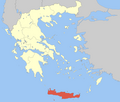Rethymno
Rethymnon (Greek: Ρέθυμνο [ˈreθimno], Italian:Rettimo, Latin: Civitas Rethymnæ, Turkish: Resmo) is a city in Greece on the island of Crete. It is the capital of Rethymno regional unit, and has a population of more than 35,000 inhabitants (nearly 40,000 for the municipal unit). It is believed to have been built on the site of the earlier city of Rhithymna. History  Rethymno is believed to have been built on the site of the earlier city of Rhithymna.[2][3] Some sources mention a city called Arsinoe which some scholars have proposed stood at the same site.[4][5][6] Rethymno began a period of growth when the Venetian conquerors of the island decided to establish an intermediate commercial station between Heraklion and Chania, acquiring its own bishop and nobility in the process. Today's old town (palia poli) was almost entirely built by the Republic of Venice. It is one of the best-preserved old towns in Crete. From circa 1250 the city was the seat of the Latin Diocese of Retimo, which was renamed Retimo–Ario after the absorption in 1551 of the Diocese of Ario. The town still maintains its old aristocratic appearance, with its buildings dating from the 16th century, arched doorways, stone staircases, Byzantine remains, the small Venetian harbour and narrow streets. The Venetian Loggia houses the information office of the Ministry of Culture and Sports. A Wine Festival is held there annually at the beginning of July. Another festival, in memory of the destruction of the Arkadi Monastery, is held on 7–8 November. The city's Venetian-era citadel, the Fortezza of Rethymno, is one of the best-preserved castles in Crete. Other monuments include the Neradje Mosque (the Municipal Odeon arts centre), the Great Gate (Μεγάλη Πόρτα or "Porta Guora"), the Piazza Rimondi and the Loggia. The town was captured by the Ottoman Empire in 1646 during the Cretan War (1645–69) and they ruled it for almost three centuries. The town, called Resmo in Turkish, was the centre of a sanjak (administrative part of a province) during Ottoman rule. During the Battle of Crete (20–30 May 1941), the Battle of Rethymno was fought between German paratroopers and combined forces of the Second Australian Imperial Force and the Hellenic Army. Although initially unsuccessful, eventually the Germans won the battle after receiving reinforcements airlifted to Maleme in the northwestern part of the island. Today the city's main source of income is tourism, with many new facilities having been built in the past 20 years. Agriculture is also notable, especially olive oil and other Mediterranean products. Municipality    The municipality of Rethymno was formed at the 2011 local government reform by the merger of the following 4 former municipalities, that became municipal units:[7]
CultureRethymno is home to the following museums:
The Treasure Hunt of Rethymno is a game played by local people and takes place two weeks before Carnival.[9] LiteraturePandelis Prevelakis wrote Το χρονικό μιας πολιτείας (1937), The Chronicle of a Town, a nostalgic depiction of Rethymno from the period of the Cretan State (1898) to the expulsion of the Cretan Turks (1924). SportsRethymno hosted the international athletics meeting known as Vardinogianneia. The athletics meeting stopped in 2012 due to Greek financial crisis.[10] Rethymno has many sport clubs with presence in Panhellenic championships of various sports. Below is alist of the main sport clubs of Rethymno.
EducationIn the Rethymno Campus of the University of Crete are located the School of Philosophy, the School of Education, the School of Social, Economics and Political Sciences, and the University Library of the University of Crete. On a yearly basis, there are about 8.000 students studying at "Galos" where the Campus and the Academic Institute of Mediterranean Studies are located. Also in Rethymnon is located the School of Music and Optoacoustic Technologies of the Hellenic Mediterranean University.[11] Finally, in Rethymno, Tria Monastiria area is located the international research Institute of Plasma Physics and Laser[12] of the Hellenic Mediterranean University which is the access point of the National Research Facility HELLAS-CH . GeographyClimate
Notable locals
International relationsRethymno is twinned with : Gallery
See alsoReferences
External linksWikimedia Commons has media related to Municipality of Rethymno.
|
||||||||||||||||||||||||||||||||||||||||||||||||||||||||||||||||||||||||||||||||||||||||||||||||||||||||||||||||||||||||||||||||||||||||||||||||||||||||||||||||||||||||||||||||||||||||||||||||||||||||||||||||||||||||||||||||||||||||||||||||||||||||||||||||||||||||||||||||||||||||||||||||||||||||||||||||||||||

























